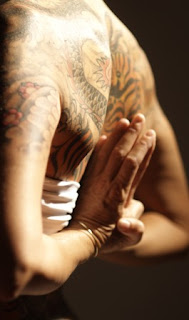Astrologically,
yoga refers to the planetary combinations and their special results, which
affect the life of an individual. In traditional Indian ephemeris, known
as Panchangam, yoga is also the name of a particular division of time,
which are 27 in number. This time-division is different from the asterisms,
which are also 27 in number.
Find
below a list of such yogas arranged in alphabetical order for your convenience.
ADHI
YOGA
An
auspicious planetary combination formed by benefices in the 6th, 7th and
8th houses from the Moon sign while Mercury is not combust and Jupiter
does not form Sakata yoga. It makes an individual polite, trustworthy,
affluent and capable of defeating his adversaries
.
AKHAND
SAMRAJYA YOGA
A
planetary combination producing a long life of affluence formed by Leo,
Scorpio, Aquarius or Taurus as Ascendant, making Jupiter rule either the
5th or the 11th house in a natal chart.
AMAR
YOGA
An
auspicious planetary combination formed in two ways,(1) all cardinal houses
occupied by all malefic, or by all benefices. Here, the native owns landed
property and real estate, and in the latter case, he becomes rich and
affluent; (2) Sun in Aries or in Leo occupies the Ascendant, or any other
cardinal or trine house while Moon is in exaltation or in its own sign,
i.e., in Cancer or Taurus, and Jupiter and Venus occupy the 8th or 12th
house in the natal chart. This yoga nullifies all evils in the horoscope.
AMARAK
YOGA
A
planetary combination formed by the lord of the 7th house placed in the
9th house, and the lord of the 9th in the 7th house while both these planets
are strong. It bestows to the native long arms, big eyes, knowledge of
law and religious scriptures. His wife is faithful to him and he leads
a pure and moral life.
ANAPHA
YOGA
A
planet other than the Sun occupying the 12th house from the Moon constitutes
Anapha yoga. Mars in this position makes the person powerful, self-controlled
and a leader of persons engaged in undesirable activities. Mercury makes
him proficient in oratory, and absorbing conversations, and skilled in
social arts. Jupiter makes the native a serious-minded, righteous person
spending money on charity. Venus makes the person a womanizer yet respected
by persons in authority. Saturn leads to disenchantment, and the nodes,
to perversity. The Moon under the yoga bestows well-formed organs, good
manners and self-respect
.
ARA
SAURI YOGA
Planetary
combination between Saturn and Mars. It produces serious afflictions.
ARDHA-CHANDRA
YOGA
A
planetary combination under which all planets occupy consecutive houses
leaving the intervening cardinal houses vacant. The individual under this
combination is happy, handsome, and is provided with much ornaments, gems
and jewels.
ARISTHA
YOGAS
Planetary
combinations producing misfortune. These combinations nullify auspicious
results and produce hardships. Some of these combinations are:
(i)
Malefic associated with the 6th, 8th and 12th houses or their lords; (ii)
Malefic aspects on a weak Moon (iii) Sun, Mars, and Saturn in the 5th
house (iv) Mars, Saturn, or Sun in the 8th house (v) malefic aspect on
weak Ascendant lord, Sun or Moon (vi) Sun, Mars, Rahu and Saturn in Ascendant
(vii) exchange of signs between Jupiter and Mars (viii) Mars and Saturn
in the 2nd house while Rahu occupies the 3rd house (ix) Rahu in the 4th,
and Moon in the 6th or 8th house x) Mars in the 7th, Venus in the 8th
and Sun in the 9th house (xi) Malefic in the 7th and 12th houses (xii)
Jupiter, Sun, Rahu and Mars occupy signs of malefic Planets while Venus
is in the 7th house (xiii) lord of Ascendant associated with a malefic
or flanked by two malefics, and a malefic positioned in the 7th house
(xiv) Saturn in the 8th house, Moon in Ascendant, or Venus and Moon in
the 6th or 8th House (xv) Moon and Mercury in the 6th or 8th house.
ASHTA
LAKSHMI YOGA
When
Rahu is in 6th and Jupiter in Kendra this is formed. Wealthy conseendition
and happiness is
.
AVATARA
YOGA
A
planetary combination formed by (i) the Ascendant occupying a cardinal
Sign,and Venus and Jupiter in 1st, 4th, 7th or 10th houses, and (iii)
Saturn in exaltation. The combination bestows spiritual blessings uplifting
the individual's mind and heart enabling him to attain mystic awareness
and inner wisdom. He becomes an erudite and deep student of religious
and esoteric literature with psychic susceptibilities. The combination
also bestows high status in society, renown for meritorious deeds and
pilgrimages to religious and historical places.
Free Web Directory


















 described as Hatha, it will likely be a slow-paced stretching class with some simple breathing exercises and perhaps seated meditation. This is a good place to learn basic poses, relaxation techniques, and become comfortable with yoga.
described as Hatha, it will likely be a slow-paced stretching class with some simple breathing exercises and perhaps seated meditation. This is a good place to learn basic poses, relaxation techniques, and become comfortable with yoga.
